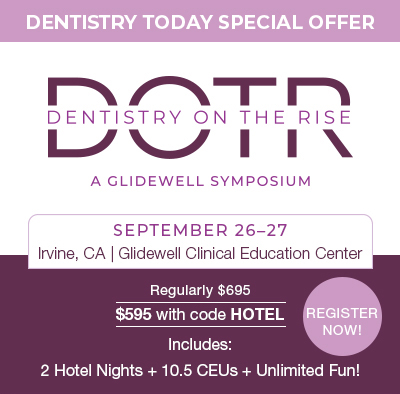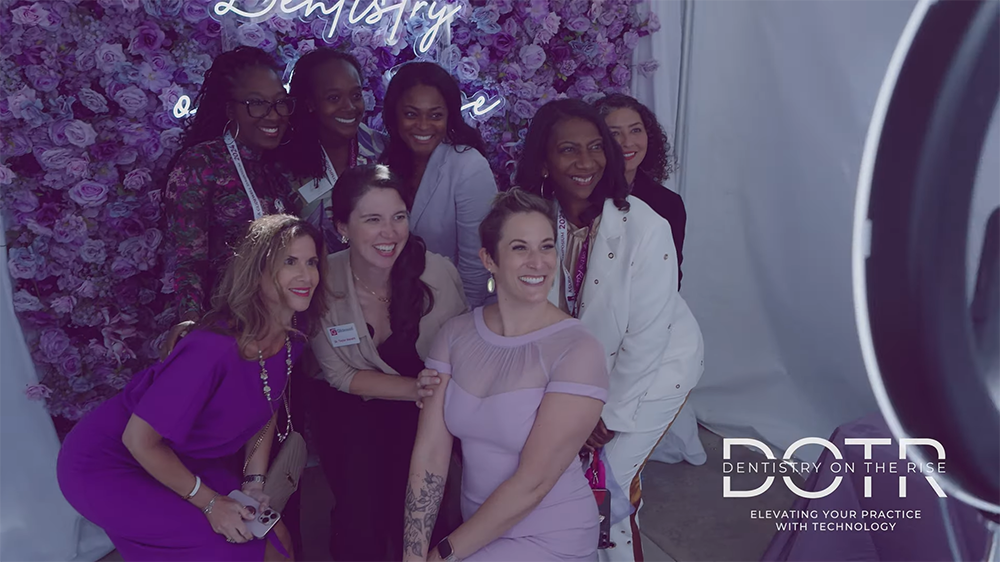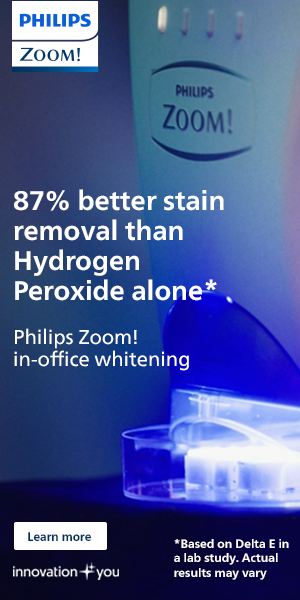Written by: Conrad Rensburg, ND, NHD
INTRODUCTION
Dr. Paulo Malo, a leading innovator in implant dentistry, documented the first successful rehabilitation of a fully edentulous patient using 4 strategically placed implants in 1998. This technique has revolutionized full-arch rehabilitations for the edentulous patient. Over the last 25 years, the All-on-4 (All-on-X) protocol has gained widespread acceptance among both clinicians and researchers. It has been extensively studied, with research consistently demonstrating high success rates over long-term followups.1
However, throughout the evolution of this innovative procedure, 2 restrictive and severely limiting processes were identified: the collection of records in an analog format and the questionable transfer of a patient’s vertical dimension of occlusion (VDO) and aesthetic requirements through a chairside processed prosthesis.
It is generally accepted that implant-supported, full-arch rehabilitations utilizing the All-on-X or similar protocols typically require 4 to 6 clinical appointments to complete. However, this streamlined treatment timeline is highly dependent on precise surgical execution and accurate prosthetic planning. In reality, the number of appointments may increase significantly if complications arise which often necessitate additional clinical visits for adjustments, remakes, or corrective procedures.2 Even in immediate-load All-on-4 cases, deviations in surgical or restorative execution could prolong treatment and compromise outcomes, emphasizing the importance of a coordinated interdisciplinary approach to reduce clinical visits and ensure predictable results.
In many cases, the lack of available digital technology to plan and accurately execute these procedures contributed to many of the restorative and surgical errors, causing frustration to both patient and clinical teams.
The Link Between Planning, Surgery, and the Final Restoration
In 2011, Babbush et al3 investigated the success rate of immediately loading patients with a chairside conversion prosthesis following implant placement. The study involved 165 patients who received a total of 708 implants, all of which were immediately loaded with a fixed prosthesis on the day of surgery. The results demonstrated a cumulative survival rate of 99.6% over a follow-up period of up to 29 months. This study underscored the efficacy of immediate loading protocols in the All-on-4 treatment.
Unfortunately, these chairside conversion procedures were processed in analog and primarily relied on an unreliable nose-chin marking to help re-establish the patient’s VDO.
Although these temporary prosthetics demonstrated significant value in stabilizing the implants during the healing process, chairside processing of these devices added hours to an already lengthy surgical procedure, and the chairside-processed VDO proved questionable at best.
In 2024, Mahato et al4 conducted a comparative study evaluating the impact of digital vs analog impression techniques on restorative workflow efficiency, prosthesis quality, and patient comfort. The findings revealed significant advantages of digital impressions over traditional analog methods. These included notable time savings, reduced overall costs, and improved patient experience. Furthermore, digital workflows resulted in shorter fabrication timelines and prostheses that required fewer chairside adjustments, contributing to a more streamlined and predictable restorative process.
As CAD technology evolved, it afforded the technical team the ability to file-match different stage, STL scans by matching common reference points on the X, Y, and Z axes. This technology enabled the conversion prosthesis to play a more critical role in integrating planning, surgery, and the final restoration by accurately transferring the desired bite throughout the process.
These advances enabled accurate data transfer between the preoperative, prototype try-in, and final restoration. Today, an accurately converted prosthesis has become a vital healing and prototype device and has ultimately become the first step in the restorative process. Through this workflow, modern-day clinicians can now successfully restore the final hybrid prosthesis in as few as 2 very predictable clinical appointments.
Fully Digital Workflow
To restore an All-on-X case using a complete digital (model-free) workflow, the restorative team must eliminate 2 analog processes: PVS-based impression taking, which requires printed or poured models, and the use of a cemented titanium interface between the zirconia hybrid and the MUA intraoral connection.
IO Scanning, Photogrammetry, and Interface Elimination
Initially, many clinicians purchased intraoral (IO) scanners in the hope of gathering data on an All-on-X case in a digital format. Unfortunately, these scanners, although proven to be accurate enough for this application by multiple studies,5 struggle to acquire their position in the edentulous arch, rendering IO scanners sometimes ineffective and the process extremely time consuming. The introduction of photogrammetry-based extraoral cameras addressed the issue of arduous, edentulous data capturing; however, this technology requires a significant financial commitment and specialized fabrication and design services to process the conversion data on the day of surgery. This design process is often slow, and a patient waiting for his or her conversion prosthesis after surgery frequently creates an unnecessarily stressful day for the surgical and technical teams.
Furthermore, excluding the titanium interface from the process is essential because it eliminates the need for a physical model and, more importantly, creates a disposable “no-repair” prosthesis that can be easily recreated from archived data with the press of a button.
This can be easily accomplished in the final zirconia hybrid through multiple technologies, such as Atlantis CustomBase (Dentsply Sirona) (Figure 1) or Nobel Procera Zirconia Bridge (Nobel Bioocare), as well as other proprietary workflows.

Unfortunately, these technologies do not eliminate the need for a titanium interface in the conversion prosthesis or prototype phase. With access to today’s technologies, there is no reason to waste expensive chair time capturing data to repair a broken conversion, prototype, or even final hybrid.
Ultimately, using titanium-free connections is as crucial for the conversion prosthesis (Figure 2) as it is for the final restoration. Choosing the right scan flag is imperative in a complete digital workflow. Examples of such systems are Powerball, DESS Design FLAT SEAT, Rosen screw, DirectScan, and others.

Scan Aid Technology
In 2023, Kernen et al6 demonstrated that utilizing a scan aid to position an intraoral scanner in space, especially in edentulous patients, facilitates a predictable scan process and ultimately produces accurate scan data.
Using innovative devices like the S.I.M. (smart implant mapping) device (NavaGation) (Figure 3) or similar technologies like ARCHTRACER (digital arches) now allows the surgeon to accurately capture intraoral data for All-on-X application without the need for special equipment or even photogrammetry-based capture devices.

Surgical Conversion: Case Study
This documented case study addresses all the restrictive analog and arduous hand processes identified in this article: the need for expensive data capture equipment, model-based workflows, potential repair of a broken prosthesis,7 and, most importantly, the need for traditional chairside processing of the post-surgical temporary hybrid.8
The EZ Load workflow (NavaGation) can be incorporated into guided, latched, stackable or even freehand surgeries. This workflow is less restrictive on the surgeon, significantly reduces the surgical procedure time, and ultimately facilitates a 2-appointment prototype (Figure 4) to final zirconia hybrid delivery (Figure 5).


Treatment Plan
This case report presents the management of a 79-year-old patient with a history of dental implants in the maxillary and mandibular arches, including a lower complete denture retained by 2 implants with LOCATOR abutments (Zest Dental Solutions) (Figure 6). The remaining maxillary dentition exhibited progressive failure, leading to chronic periapical infections and systemic inflammation (Figure 7). Given the patient’s need for cardiac surgery, the treating cardiologist recommended addressing all dental infections before the procedure.



To address these concerns, a comprehensive, implant-supported rehabilitation plan was devised, integrating existing implants with newly placed fixtures to restore the maxillary arch using a fixed-implant prosthesis. To optimize the surgical procedure and reduce chair time, the EZ Load conversion system was incorporated into the custom NavaGation surgical guide plan (Figure 8). The treatment approach prioritized an FP1 prosthetic design within a fully digital workflow. This surgical strategy aimed to enhance patient comfort, reduce surgical chair time, initiate soft-tissue conditioning, and optimize the transition to a definitive zirconia FP1 restoration.
Data Capture, Diagnostic Design, and Surgical Planning
Dr. Holger Meiser, from the Holger Dental Group in Minneapolis, captured DICOM data, patient photographs, and IO scans (Figure 9) of the working and opposing arches. The data was digitally transferred to the NavaGation Synergy team in Chapel Hill, NC. A digital diagnostic design (Figure 10) was done by the Absolute Dental Lab Digital Design team, and a custom surgical plan based on the approved design was then completed by the NavaGation surgical team for remote review and approval by the surgeon.


The case was strategically planned to involve sequential tooth extractions, creating additional implant site options yet still preserving adequate structure to support the guide. Dr. Meiser remotely reviewed the surgical plan with the design team and made necessary adjustments to ensure a predictable surgical procedure. Dr. Meiser requested the EZ Load conversion process and custom S.I.M. 3D implant scanning device be designed in conjunction with the case.
After approval, the technical team fabricated the surgical guide and archived the smile design, which was ready for implant position matching on the day of surgery (Figure 11). The case was assembled, the surgical plan and sequence were carefully documented, and the case was shipped 1 week before the planned surgery. This allows the surgeon adequate opportunity to familiarize themselves with the case and time to further communicate with the technical team if necessary.

Surgery Day: Seating the Device
Dr. Meiser verified the accurate seating of the tooth-borne S.I.M. fixation guide (Figure 12) using the patient’s pre-op tooth structures. The CBCT-directed fixation guide was designed for a 1.6- x 16-mm guide drill. To avoid potential over-drilling, it was digitally planned for accurate depth and directional control. The patient-specific S.I.M. device uses active anatomical seating verification by engaging the palatal anatomy captured by the IO scans. The device is fixated by a single (or dual) 2.0 x 14 mm LeForte screw (Jeil Medical).


After positive seating of the S.I.M. device (Figure 13), Dr. Meiser used a TRIOS 4 IO scanner (3Shape) to capture the pre-op working arch. This initial data set establishes a model-matching reference point that the technical team will use for model matching; this data relates the pre-op tooth structures to the S.I.M. device.
Surgery and Data Capture
Dr. Meiser removed the current implant crowns and sequentially extracted existing teeth as directed by the NavaGation surgical plan. Because of the ideal existing bone contour and adequate natural restorative clearance, the case was planned for an FP1 transitional and final prosthesis. Dr. Meiser’s implant of choice was Legacy 2 (Implant Direct). They are specifically designed for bone-level placement and feature a dual-lead thread for enhanced primary stability, making them very suitable for immediate loading. Dr. Meiser achieved adequate primary stability with implant delivery. The team then utilized the pre-planned NavaGation abutment aligner to deliver the multi-unit abutments. This creates a secure restorative platform and aligns the screw access positions within the restorative parameters set by the diagnostic design.
After positive seating of the multi-unit abutments were confirmed (as discussed earlier in this article), Dr. Holger placed the specific MUA implant scan flags to support the titanium-free interface conversion prosthesis (Figure 14). Before extracting the remaining dentition, the implant positions are indexed in relation to the S.I.M. device by scanning the arch (Figure 15). Leaving the additional tooth structures further helps with an accurate model match of the data sets. Because time is of the essence and to ensure immediate data transfer, the files were sent to the Absolute Dental team by dropping the data directly into the upload portal at absolutedentallab.com. To allow the design team to start the implant match without any delay, the file transfer was confirmed with a phone call. The technical team then aligned the pre-op and diagnostic design files with the S.I.M. pre-op and implant scans. Dr. Holger elected to finalize the conversion prosthesis the same day with an in-office print solution and chose the 20-minute FP1 design file delivery option.



The laboratory design team matched all the data set points and combined the diagnostic design with the implant position data set (Figure 16). This pre-design workflow allows for an extremely expedited process; after completion the STL file was digitally transferred to allow Dr. Holger and his team to process the prosthesis in-house.
Hands-Free Conversion Process
The prosthesis was printed on a Pro 2 in-office printer (SprintRay), utilizing OnX Tough 2 printing resin (SprintRay). This additive resin is FDA-cleared specifically for fixed hybrid denture applications (Figure 17).

Because the data capture and design process was completed in a fully digital workflow and created from the patient’s pre-op VDO (or set bite) as a foundation, there was no need for any chairside luting or bite adjustments (Figures18 to 20).



It is important to note that the prosthetic screws are seated into a printed resin instead of a traditional rigid alloy interface, therefore a special seating technique is required to ensure proper seating and to minimize the chances of post-delivery screw loosening.
It is recommended to hand tighten the screws in 3 stages with 10- to 15-minute intervals. This allows the material to settle before releasing the patient. A hand torque of around 10 to 15 Ncm is appropriate.
CONCLUSION
Advancements in digital technology, contemporary materials, and modern processing techniques serve as the cohesive elements that unify the restorative, technical, and surgical teams into a highly effective collaborative unit. These innovations facilitate the creation of a precise, transferable diagnostic plan, which forms the foundation for accurate surgical execution and ultimately supports the delivery of a successful final restoration.
The postsurgical provisional prosthesis is no longer fabricated chairside using outdated, labor-intensive workflows. Instead, digital protocols have eliminated the need for conventional acrylic luting, manual adjustments, and analog verification of VDO. These parameters are now fully established within the digital planning phase. The result is a diagnostically driven, digitally fabricated conversion prosthesis that functions both as a healing appliance and as a preliminary prototype guiding the final aesthetic and functional outcome.
Moreover, digital data archiving enables on-demand reproduction of the transitional or final prosthesis. This process effectively creates a disposable device, enhancing efficiency and predictability.
This comprehensive workflow accommodates both guided and freehand surgical approaches while empowering the restorative team to deliver the definitive hybrid restoration within a fully digital framework—often in as few as 2 clinical appointments.
By leveraging this collaborative, technology-driven approach, clinicians are equipped to manage previously complex cases with increased confidence and reduced chair time, leading to a streamlined process and improved patient satisfaction.
ACKNOWLEDGMENTS
The author expresses sincere appreciation to Dr. Holger Meiser of the Holger Dental Group for his thorough documentation of this case and for his consistently demonstrated excellence in both surgical and restorative disciplines across numerous complex cases. Gratitude is also extended to Matt Vrhovac and the NavaGation Synergy team for their significant contributions to the ongoing development, testing, and validation of the innovative surgical workflows presented in this report. Special recognition is given to Jack Marrano, Jay Brill, and Drew van Aarde for their exceptional prosthetic artistry, supported by the skilled members of the Absolute Dental ART Team.
Absolute Dental Laboratory is a proud member of the Denbright Dental Group (denbright.com), a consortium of 7 premier US dental laboratories, including Frontier Dental Lab, Burbank Dental Lab, Nu-Art Dental Lab, Jason J. Kim Dental Lab Aesthetics, D&S Dental Laboratory, and Friendship Dental Lab.
REFERENCES
1. Malo P, de Araújo Nobre M, Lopes A, et al. A longitudinal study of the survival of All-on-4 implants in the mandible with up to 10 years of follow-up. J Am Dent Assoc. 2011 Mar;142(3):310-20. doi: 10.14219/jada.archive.2011.0170.
2. Holtzclaw D. All-on-4 implant treatment: common pitfalls and methods to overcome them. Compend Contin Educ Dent. 2016 Jul;37(7):458-465;quiz466. PMID: 27548398..
3. Babbush CA, Kutsko GT, Brokloff J. The all-on-four immediate function treatment concept with NobelActive implants: a retrospective study. J Oral Implantol. 2011 Aug;37(4):431-45. doi: 10.1563/AAID-JOI-D-10-00133. Epub 2010 Dec 27.
4. Mahato M, Hota S, Jain A, et al. Comparison of conventional and digital workflows in the fabrication of fixed prostheses: a systematic review. Cureus. 2024;16(6):e61764. doi:10.7759/cureus.61764
5. Papaspyridakos P, De Souza A, Finkelman M, et al. Digital vs conventional full-arch implant impressions: A retrospective analysis of 36 edentulous jaws. J Prosthodont. 2023;32(4):325–30. doi:10.1111/jopr.13536
6. Kernen F, Brändle D, Wagendorf O, et al. Enhancing intraoral scanner accuracy using scan aid for multiple implants in the edentulous arch: An in vivo study. Clin Oral Implants Res. 2023;34(8):793-801. doi:10.1111/clr.14107
7. Rensburg CJ. Digital synergy for full-Arch hybrid solutions. Compend Contin Educ Dent. 2022;18(1):22.
ABOUT THE AUTHOR
Mr. Rensburg is the director of Absolute Dental Laboratories, headquartered in the Triangle region of North Carolina. He earned a 4-year Baccalaureate degree from Pretoria Tech in 1992, graduating under a full academic scholarship. He specializes in fixed dental prosthetics, with a particular emphasis on dental implantology. He is an active member of the Academy of Osseointegration, the American College of Prosthodontists, and the PEERS network. As a continuing education-accredited speaker since 2002, he has delivered hundreds of presentations across the United States. Mr. Rensburg is also the author of numerous peer-reviewed publications, with research interests centered on CAD/CAM implant design protocols, fixed hybrid implant restorations, digital removable prosthodontics, and contemporary digital communication methodologies in clinical dentistry. He can be reached at conrad@absolutedentalservices.com or through the website absolutedentallab.com.
Disclosure: Mr. Rensburg is the owner of DDS Company, NavaGation Precision Guidance, Synergy EZ Load, and Smart Mapping IP (patent pending).
FREE CE WEBINAR
There is an upcoming FREE CE WEBINAR that will follow up on this article.
It takes place on July 24 at 7 PM (Eastern Time).




